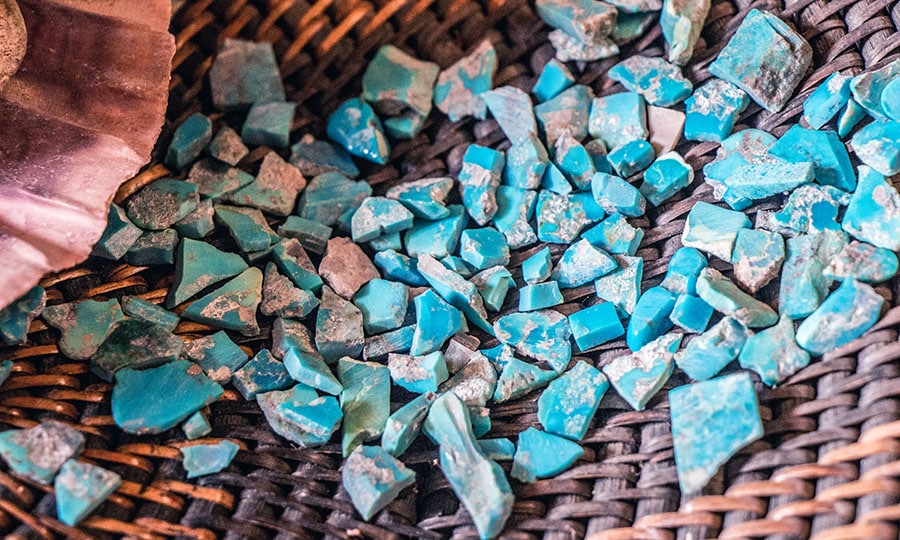What is Natural Turquoise?

The idea of “natural” in the turquoise industry can be a little confusing. We often hear consumers and collectors ask if a piece of turquoise is real, if it is natural, or if it is imitation. What does that even mean?
To start, I want to define some common terms. By definition, the term “natural” refers the way something is found in nature. However there is a more precise term used for this for turquoise. Turquoise in nature is called “raw” turquoise. Raw turquoise is formed in the earth over thousands of years. Another very similar term is “rough” turquoise. Rough turquoise is a chunk of raw turquoise that has been pulled from the earth, usually in nugget, chalk or dust form.
The main purpose of turquoise is to be used as a gemstone, to be admired and displayed in fashionable jewelry. Raw or rough turquoise is not usually very pretty, nor is it in a stable state to be displayed in jewelry. In fact, about 90% of rough turquoise cannot even be used in jewelry without being enhanced in some way.
Generally gemstones like turquoise are cut and polished to be more presentable. The processes of polishing the stone and cutting it into a usable shape makes the stone attractive. Turquoise by nature has physically porous and absorptive characteristics, which make turquoise act like a sponge. Touching the stone with bare hands can expose the stone to skin oils that are absorbed by the stone, forever changing its composition. Introducing water during the polishing process can change the stone depending on the purity of the water. So is the stone still natural? Yes. It is generally accepted that polishing the stone just makes it smooth, and any water or oils absorbed are negligible.
What do we do about the stone absorbing more in the future? Protective waxes and oils can be applied to the surface of the stone, to help it from being exposed to other foreign chemicals. The ancient Egyptians used this technique to keep their ornamental turquoise stones protected. Is the stone still considered natural? Generally, yes. It just now has a little wax on it… Right?
Ok, well turquoise is soft and it can crack easily and that wax isn’t going to last forever. More modern techniques included infusing the turquoise stones with a chemicals then heating the stones to eliminate traces of these foreign chemicals. This makes the stone a little harder and helps to protect it from foreign oils and keeps the color nice at for many years to come. When it is tested according the Gemological Institute of American (GIA) standards, it is still 100% natural turquoise. But is this still natural? Ok now things are getting a little confusing… Where do you see the line?
The GIA and the dictionary has set the foundation by defining what is turquoise. However, because the stone can be exposed to so many different processes, many corresponding terms have popped up in the industry that attempt to define the state of turquoise more accurately. These terms can sometimes seem misleading, as many have been created in the past to help sell turquoise. So I hope I can help clear up the definitions of “natural turquoise”, “real turquoise” and “imitation turquoise” for you.
The line for “Natural” turquoise must be drawn somewhere. If 99% of the stone is concluded to be untreated (as defined by the GIA) it can be called natural.
It is not common to have stones tested, because a sample of the original stone must be extracted and can not be recovered. The GIA gives us a fancy identification method using infrared spectroscopy and X-Ray powder diffraction. Instead of testing every stone, collectors and sellers in the industry only need to know the history of the stone. There are particular treatments that are known to be minimally evasive and maintain the quality of the stone composition. A stone that is called “natural” basically means the stone has only undergone professional and minimal treatment, if any. Sellers are required to tell you if a stone is natural and if it has undergone any type of treatment. Not doing means the turquoise is being misrepresented and the seller is falsely advertising their product.
So that leads to the question; what do we call turquoise that is not natural? If less that 99% of the stone is natural does that mean it is not real turquoise? No, it just means the stone is not natural. The turquoise can still be real, but more than 1% of its composition has been enhanced. It is still real turquoise because a good part of stone is still raw turquoise, but not enough to be labeled as natural. As long as 50% of the stone is actual chemically turquoise, then it can be labeled as real turquoise.
So what is imitation turquoise? If less than 50% of the stone is chemically turquoise, then it is known as imitation turquoise. Even if there are traces of raw turquoise in the stone, it is not enough to be labeled “natural” or even “enhanced.” Often, there is not any actual turquoise in the turquoise at all. The most common types of imitation turquoise are other stones that look similar to turquoise (such as magnesite and howlite) that have been dyed a turquoise color. Imitation can be plastic. Imitation turquoise that is made by machine is called synthetic turquoise.









